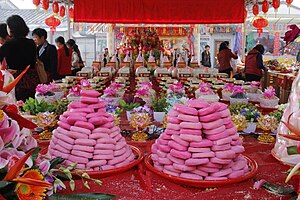Tao kuih

Tao kuih(Chinese:Hồng đào quả) is a kind of traditional food inChaoshanarea, Guangdong, China. Tao meanspeachin Chinese and kuih ( quả ) is a general name of a class of food, which is made fromrice flour,flour and tapioca. “Tịnh mễ dã, hựu mễ thực dã” is the explanation of kuih from Kangxi Dictionary.[1] InChaoshanarea, the housewife always make tao kuih in some big festivals, such asSpring Festival,Lantern Festival,Double Ninth Festivaland so on. Tao kuih uses to sacrifice to ancestors. Tao kuih gets its name because people think it looks like a redpeach.It is made for worship. In China, red peach symbolizes longevity and luck, it reflects people's aspiration when they pray.
Ingredients
[edit]
Main ingredients include rice flour,glutinous rice,mushroom,tiniest shrimps,peanut,garlic,pork, etc.[2]Additional ingredients can include MSG, pepper, oil, salt, etc.[2]
Nutritional value
[edit]Glutinous rice is the main filling of tao kuih, which fully contains proteins, fat, saccharides, starch, Ca, F, Fe, vitamin B1, vitamin B2.[3]Traditional Chinese medical science think it can invigorate spleen-stomach and replenishQi,and it do help to your spleen and stomach. What is more, glutinous rice can remission frequency of urination.
kuih mould
[edit]
Tao kuih always have beautiful patterns on it because of tao kuih mould. Tao kuih moulds have various kinds of patterns in different area, which is mainly make from peach woods. Peaches also reflect longevity and good marriage, and most of the tao kuih will have a “Thọ” (longevity) or “Phúc” (luck) Chinese character on it. The patterns of those moulds are always very exquisite, so peach wooden moulds need to be carved carefully. It had developed to be a kind of engraving art, which enriches Chinese carving culture.[4]
